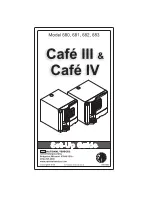
PRINCIPLE OF OPERATION
How it works
In the ice makers the water used to make the ice
is kept constantly in circulation by a water pump
which primes it to the spray system nozzles from
where it is diverted into the inverted cup molds of
the evaporator (Fig. A).
A small quantity of the sprayed water freezes into
ice; the rest of it cascades by gravity into the
sump assembly below for recirculation.
FREEZING CYCLE
(Fig. B)
The hot gas refrigerant discharged out from the
compressor reaches the condenser where, being
cooled down, condenses into liquid. Flowing into
the liquid line it passes through the drier/filter,
then it goes all the way through the capillary tube
where it looses its pressure.
Next the refrigerant enters into the evaporator
serpentine (which has a larger diameter then the
capillary tube) and starts to boil off; this reaction
is emphasized by the heat transferred by the
sprayed water.
The refrigerant then increases in volume and
changes entirely into vapor.
The vapor refrigerant then passes through the
suction accumulator (used to prevent that any
small amount of liquid refrigerant may reach the
compressor) and through the suction line. In both
the accumulator and the suction line it exchanges
heat with the refrigerant flowing into the capillary
tube (warmer), before to be sucked in the
compressor and to be recirculated as hot
compressed refrigerant gas.
The freezing cycle on SCE 20 - 30 - 40 - 50 is
controlled by only the evaporator thermostat
which has its bulb in contact with the evaporator
serpentine while in SCE 65 - 90 - 105 there is
an second phase controlled by an electronic
timer.
The electrical components in operation during
the freezing cycle are:
COMPRESSOR
WATER PUMP
FAN MOTOR
(in air cooled version)
On air cooled versions the refrigerant head
pressure is gradually reduced from the value of
approx. 11 bar at beginning of the freezing cycle
with the machine at 21
°
C ambient temperature,
to a minimum value of approx. 7 bar just at the
end of the freezing cycle, few seconds before the
starting of the defrost cycle.
The declining of the pressure is relied to the
reduction of the evaporating pressure, caused
by the progressive growth of the ice thickness
into the inverted cup molds and to the flow of air
drown through the air cooled condenser by the
fan motor.
The above values are in relation as well to the
ambient temperature of the ice maker site and
they are subject to rise with the increase of this
temperature.
On water cooled versions the refrigerant head
pressure ranges between 8,5 and 10 bar being
controlled by an automatic hi pressure control
that energizes a water solenoid valve located on
the water line to the condenser, which rates the
cooling water to the condenser.
On SCE 90 - 105 water cooled version operating,
the head pressure is constant controlled by a
water regulating valve.
At starting of the freezing cycle the refrigerant
suction or lo-pressure lowers rapidly to 1,0 bar
then it declines gradually – in relation with the
growing of the ice thickness – to reach, at the end
of the cycle, approx. 0-0,1 bar with the cubes fully
formed in the cup molds.
DEFROST OR HARVEST CYCLE
(Fig. D)
On SCE 20 - 30 - 40 - 50 the temperature of the
evaporator thermostat, in contact with the
evaporator serpentine, drops to a pre-set value
it changes its electrical contacts energizing
the herebelow shown components.
(On SCE 65 - 90 - 105 when the electro-nic timer
completes the second portion of the freezing it
changes its electrical contacts energizing the
same components).
COMPRESSOR
WATER INLET SOLENOID VALVE
HOT GAS SOLENOID VALVE
The incoming water, passing through the water
inlet valve and the flow control, runs over the
evaporator platen and then flows by gravity
through the dribbler holes down into the sump/
reservoir (Fig. C).
The water filling the sump/reservoir forces part of
the surplus water from the previous freezing
cycle to go out to the waste through the overflow
pipe. This overflow limits the level of the sump
water which will be used to produce the next
batch of ice cubes.
Meanwhile the refrigerant, as hot gas discharged
from the compressor, flows through the hot gas
valve directly into the evaporator serpentine by-
passing the condenser.
11












































